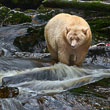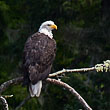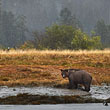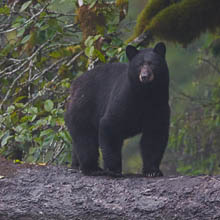Availability: To be determined
In the Field
The Magical Great Bear. Gitga'at Traditional Territory, Great Bear Rainforest, BC, Canada. September 25, 2017.
The title of this image isn't directly referring to its primary subject (that black thing on the log!), but rather to the entire scene - the absolutely magical Great Bear Rainforest. While the Great Bear may not be the best place for sun worshippers to go, it is among the best places to go if you're a nature photographer into soft lighting and dreamy, atmospheric scenes.
The total time from first spotting this bear to having it leave the scene was probably twenty seconds or less. So...I'm tempted to spend a few paragraphs talking about some of the key ingredients that go into composing and capturing memorable - but fleeting - wildlife shots (you know...things like anticipation, the value of efficient gear handling, and composure - and maintaining your compositional eye - while "under fire"). But...instead...given I captured this image with a D850 (only weeks after it was released) I think I'll opt to make a few more D850 comments!
First - and I acknowledge that this comment is PURELY subjective - one of the key things I have already noticed about the D850 is how little post-processing (relative to other Nikon DSLR's) I have to do with its raw files. For the record please note that I didn't say D850 raw files require NO post-processing...just LESS post-processing! I tend to be anal about exposure, contrast, and the tonal range of images and these variables dominate my own post-processing workflow. So I end up doing a lot of exposure-blending, selective contrast adjustment, and tone-mapping in my post-processing work. But early in the first photo tour I lead after acquiring the D850 I noticed that my raw files (whether I looked at them in Lightroom OR in Capture One Pro) - if exposed correctly - are close to the place I would "take them" with my post-processing. Great tonal range (and wonderful "subtlety of tones") plus beautiful colour - right out of the camera! This should be music to the ears of those who shy away from spending hours behind their computers.
Second - I have long believed that high resolution DSLR's, and specifically those with a small pixel-pitch, are more prone to camera-shake than are those of lower resolution (or larger pixel-pitch). Why? Simply because any given movement associated with camera shake will be "dragged" across MORE pixels if those pixels are smaller. Simple as pie. Consequently...it logically follows that if you're hand-holding a super-telephoto lens with a high-resolution camera like the Nikon D850 you likely have to bump up your shutter speed higher than you would need to with a lower-res (larger pixel-pitch) camera like a Nikon D5. That all being said, I have never actually TESTED this idea in a systematic fashion.
Fast forward to the D850 - after shooting about 10,000 images in the field with the D850 I THINK I have noticed that I have to go to higher shutter speeds when hand-holding it (with a given lens) than I do with my D5. But my gut is saying that the minimum shutter speed needs with the D850 isn't too much higher than I need with my D5 (less than one stop...or "one doubling" ...of that shutter speed). This shot, for example, was shot hand-held with a Nikon D850 paired up with a Nikkor 400mm f2.8E lens while in a moving Zodiac - at 1/400s. And it seems to have "worked".
Anyway...I've decided that I REALLY want to know the answer to this question: "Do I need to use higher shutter speeds to get sharp hand-held shots on my D850 than I do on my D5?". I hope to have the answer to that question on my blog in late October (or early November) 2017. Stay tuned...
Here's a larger (2400 pixel) version of this magical place:
• The Magical Great Bear: Download 2400 pixel image (JPEG: 1.8 MB)
ADDITIONAL NOTES:
1. This image was captured during my autumn"Into the Great Bear Rainforest" Instructional photo tour in the summer of 2017. Each year I offer trips into two different parts of the Great Bear Rainforest as well as one to photograph marine mammals and oceanscapes near the northern tip of Vancouver Island. And, in selected years, I also offer photo tours to locations to capture other highly sought-after subjects, such as Dall Sheep, Bald Eagles, and more. Details about these trips can be found on the Photo Tours page of this website.
2. This image - in all resolutions - is protected by copyright. I'm fine with personal uses of them (including use as desktop backgrounds or screensavers on your own computer), but unauthorized commercial use of the image is prohibited by law. Thanks in advance for respecting my copyright!
3. Like all wildlife photographs on this website, this image was captured following the strict ethical guidelines described in The Wildlife FIRST! Principles of Photographer Conduct. I encourage all wildlife photographers to always put the welfare of their subjects above the value of their photographs.
Behind the Camera
The Magical Great Bear. Gitga'at Traditional Territory, Great Bear Rainforest, BC, Canada. September 25, 2017.
Digital Capture; Compressed RAW (NEF) 14-bit format; ISO 2800.
Nikon D850 paired with Nikkor 400mm f2.8E. Hand-held from floating Zodiac. VR on and in Sport mode.
1/400s @ f3.5; no compensation from "recommended" matrix-metered exposure setting.
At the Computer
The Magical Great Bear. Gitga'at Traditional Territory, Great Bear Rainforest, BC, Canada. September 25, 2017.
RAW Conversion to 16-bit TIFF using Phase One's Capture One Pro 10. Three raw variants (different versions of a single raw capture) processed, with the variants differing in exposure (0.3 stops total), shadow recovery settings, and noise reduction settings.
Further digital corrections on resulting 16-bit TIFF files using Adobe's Photoshop CC 2017 and Light Crafts Lightzone. Photoshop adjustments included compositing (blending) of the three output files from the raw converter, selective curves (contrast) adjustment, minor colour desaturation, and final selective sharpening for web output. Final tone-tweaking performed using LightZone's "tonemapper" tool.
Conservation
The Magical Great Bear. Gitga'at Traditional Territory, Great Bear Rainforest, BC, Canada. September 25, 2017.
Ten percent of the revenue generated by this image will be donated to Raincoast*.
Species Status in Canada**: Not currently listed as Threatened or Endangered.
This black bear is a member of the subspecies "Kermodei" (Ursus americana kermodei). This subspecies is unique in that the population is characterized by having an unusually high proportion of a recessive gene that produces white coat colour (found on the "Spirit Bears"). Because the Black Bear is not considered under threat as a species, both the Kermodei subspecies and the very rare Spirit Bear suffer from having the same conservation designation (it should be acknowledged that in British Columbia - the jurisdiction of greatest Spirit Bear abundance - hunting of these white-coated bears is not permitted). For reasons that are not fully understood, the Spirit Bear occurs with greater frequency in a relatively small geographic area within The Great Bear Rainforest of the central and northern coast of British Columbia. In this area 10 to 30% of the bears possess white coats. Many of the black-coloured Black Bears in this region carry the gene for white coats, so allowing hunting of ANY Black Bears in this region can reduce the frequency of the gene for white coats. Thus, to protect the Spirit Bear, it is necessary to prohibit the hunting of ALL Black Bears in this region. And, very unfortunately, the globally unique ecosystem that contains the Spirit Bear is under development pressure, especially from the forestry industry. If this unique environment is altered, we may lose the wonderful genetic anomaly known as the Spirit Bear forever.
*The Raincoast Conservation Society (and Foundation) is an effective and efficient organization that has been fighting for protection of this unique habitat. If you are looking for a meaningful way to contribute to the conservation of this amazing ecosystem, Raincoast will provide maximal "bang" for your conservation dollars.
**as determined by COSEWIC: The Committee on the Status of Endangered Wildlife in Canada


























